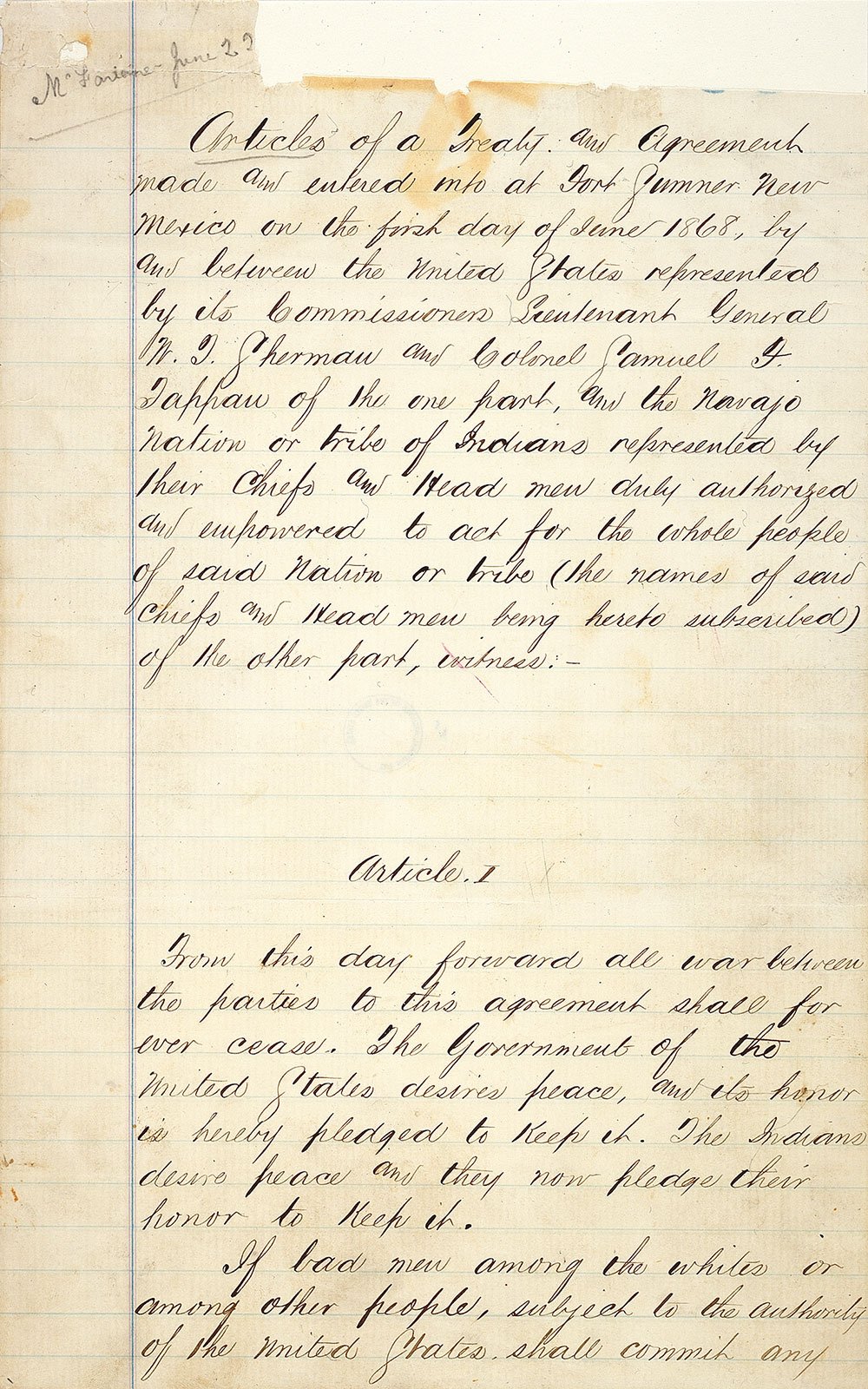
NEW MEXICO
Reconstruction Vignette
Click image to make larger
This image shows the first page of the 1868 treaty between the U.S. and the Navajo in present-day New Mexico. During the Civil War and Reconstruction, the increasingly powerful federal government destroyed Southwestern Native settlements and seized land in the name of U.S. expansion and “civilization.” Surrounded by this settler colonial enterprise and battling terrible living conditions, the Navajo at Bosque Redondo organized a meeting with federal officials in an effort to retain their sovereignty. With this treaty, the Navajo agreed to live within a designated reservation, enroll their children in English-speaking schools, and allow forts and rail lines on their land, among other concessions. They also persuaded the U.S. to recognize their sovereignty, becoming the only Native Nation to prevent removal from their homelands through a treaty.
New Mexico
Standards Overview
Coverage of Reconstruction: Partial
ZEP Standards Rubric Score: 2 out of 10
The coverage of Reconstruction in New Mexico’s standards is partial, and their content is subpar. The New Mexico Public Education Department adopted new social studies state standards in 2011. Reconstruction is covered in grades 5–8 and in high school. The terms Civil War and Reconstruction are both not capitalized in the New Mexico standards.
Grades 5–8
The social studies standards in grades 5–8 cover the period from the colonial era to Reconstruction. The final unit in the history section of the standards, the overarching goal for students studying Reconstruction is for them to “analyze the character and lasting consequences of reconstruction.”
The specific topics recommended for discussion are:
Reconstruction plans; impact of Lincoln’s assassination and the impeachment of Andrew Johnson.
Attempts to protect the rights and enhance the opportunities for freedmen by the 13th, 14th, and 15th Amendments to the United States constitution.
Post-Civil War segregation policies and their resulting impact on racial issues in the United States.
High School
The standards covering grades 9-12 are less specific than the earlier standards. Standards require students to “Analyze the impact and changes that reconstruction had on the historical, political and social development of the United States.” The standards also reference the Reconstruction Amendments and the rise of Jim Crow “following” Reconstruction.
Educator Experiences
New Mexico teachers who responded to our survey emphasized the inadequacy of the state standards’ Reconstruction content. With little guidance on the subject, teachers and schools dictate whether and how much their students learn about Reconstruction. A middle school teacher from Hobbs noted that they chose to “shorten other areas so I can spend more time on this period.” Yet, they explained that other teachers in their school did not “see the importance of spending more time teaching Reconstruction.” Because of the vagueness of the standards, students learn about Reconstruction based largely on the interest level — and, no doubt, knowledge — of their teachers.
Christopher Oglesby, an Albuquerque high school teacher, explained that their school was “very attuned to the importance of teaching reconstruction” and Oglesby was able to bring in outside resources to expand lessons. Another Albuquerque high school teacher, however, argued that the teaching of Reconstruction was “softened up and whitewashed” in their school in part due to pressures from “unsupportive and bigoted community members and admin[istrators].”
Assessment
New Mexico’s state standards on Reconstruction are inadequate. Although the New Mexico standards do cover Reconstruction, they focus on the politics and policies of Reconstruction and center white experiences and actions. Black people’s efforts to gain and defend freedom and equality do not receive mention. There is also no mention of white supremacist terrorism or any broader discussion of why and how Reconstruction came to an end. The high school standards present Jim Crow as passively “following” Reconstruction. More positively, both grade levels emphasize Reconstruction’s “lasting consequences” and impact on the “historical, political, and social development of the United States.”
Adding content that centers Black agency and advocacy and discusses white supremacist terrorism would markedly improve New Mexico’s state standards on Reconstruction. Such a revision would empower engaged educators to discuss these complex, difficult, and significant topics.
Teaching Reconstruction effectively requires centering Black people’s struggles to redefine freedom and equality and gain control of their own land and labor during and after the Civil War. Any discussion of Reconstruction must also grapple with the role of white supremacist terrorism in the defeat of Reconstruction and the negative and positive legacies of the era that persist to this day.
In January 2022, Republican lawmakers introduced HB91, a bill designed to ban the teaching of “critical race theory,” including the idea that “social problems are created by racist or patriarchal societal structures and systems.” The bill failed to advance, but its introduction is still troubling. Several respondents to our survey expressed concern about the possible chilling effects on classroom education that such bills can have around the country, particularly on discussions of the history and legacies of Reconstruction.